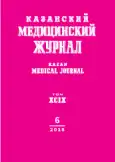Social and age-related aspects of informativeness of indirect laboratory markers of alcohol consumption
- Authors: Novikov DG1, Indutnyy AV1, Samuseva NL1
-
Affiliations:
- Omsk State Medical University
- Issue: Vol 99, No 6 (2018)
- Pages: 973-979
- Section: Social hygiene and healthcare management
- URL: https://ogarev-online.ru/kazanmedj/article/view/10515
- DOI: https://doi.org/10.17816/KMJ2018-973
- ID: 10515
Cite item
Full Text
Abstract
Aim. To compare the diagnostic capabilities of indirect laboratory markers of alcohol consumption - alanine aminotransferase, aspartate aminotransferase, gamma-glutamyltranspeptidase and carbohydrate-deficient transferrin, depending on the social status and age group of the subjects.
Methods. The activity of enzymes were assessed in the blood serum of socially adapted young subjects (18-25 years, 201 people) and adults (35-50 years, 121 people) by standard biochemical methods, and the level of carbohydrate-deficient transferrin was determined by capillary electrophoresis. With the use of questionnaires, the subjects were tested for alcohol abuse. Non-parametric criteria of statistical significance were used to evaluate the difference.
Results. No differences in the activity of enzymes associated with the level of alcohol consumption were found in the youth group (p = 0.911 for alanine aminotransferase, p = 0.669 for aspartate aminotransferase, p = 0.303 for gamma-glutamyltranspeptidase). Activity of gamma-glutamyltranspeptidase was significantly higher in adult group of alcohol abuse (p = 0.021), but individual values of enzyme activity of some subjects from this group fit into the population reference interval. Differences in the level of carbohydrate-deficient transferrin in the youth group, associated with the volume and frequency of alcohol consumption, were not revealed (p = 0.348), and all individual values were within the reference interval. In the adult group, values of this parameter were higher in high-dose alcohol drinkers (p = 0.019) but the diagnostic threshold of alcohol abuse was reached only in 2 subjects.
Conclusion. Indirect laboratory markers do not have sufficient diagnostic significance for screening of alcohol abuse among socially adapted young people and adults. Informativeness of carbohydrate-deficient transferrin may be sufficient if the diagnostic threshold corresponding to a definite social and age group replaces the standard population-established concentration limit.
Full Text
##article.viewOnOriginalSite##About the authors
D G Novikov
Omsk State Medical University
Author for correspondence.
Email: kld-omsk@mail.ru
Omsk, Russia
A V Indutnyy
Omsk State Medical University
Email: kld-omsk@mail.ru
Omsk, Russia
N L Samuseva
Omsk State Medical University
Email: kld-omsk@mail.ru
Omsk, Russia
References
- Solov’yov A.M. Comparative level of alcohol consumption in Europe. Problemy prognozirovaniya. 2016; (1): 126–133. (In Russ.)
- Niemelä O. Biomarker-Based Approaches for Assessing Alcohol Use Disorders. International Journal of Environmental Research and Public Health. 2016; 13 (2): 166. doi: 10.3390/ijerph13020166.
- Order of the Ministry of Health care of the Russian Federation #933n issued on 18.12.2015 «On the order of medical examination of intoxication (alcohol, drugs or other toxic state)». https://minjust.consultant.ru/documents/19052/. (In Russ.)
- Ogurtsov P.P., Zhirov I.V. Neotlozhnaya alkogol’naya patologiya. (Emergency alcoholic pathology.) Saint Petersburg: Nevskiy Dialekt. 2002; 120 p. (In Russ.)
- Knight J.R., Sherritt L., Shrier L.A. Validity of the CRAFFT Substance Abuse Screening Test among Adolescent Clinic Patients. Arch. Pediatr. Adolesc. Med. 2002; 156 (6): 607–614. doi: 10.1001/archpedi.156.6.607.
- Novikov D.G., Indutnyy A.V., Trofimovich N.A. et al. Clinical and biochemical aspects of coagulation control in patients with atrial fibrillation and excessive alcohol consumption. Kazanskiy meditsinskiy zhurnal. 2015; 96 (5): 734–741. (In Russ.)
- Peterson K. Biomarkers for alcohol use and abuse — a summary. Alcohol Res. Health. 2005; 28 (1): 30–37. PMID: 19006989.
- Hingson R.W., Zha W. Binge Drinking Above and Below Twice the Adolescent Thresholds and Health-Risk Behaviors. Alcohol Clin. Exp. Res. 2018; 42 (5): 904–913. doi: 10.1111/acer.13627.
- Tarasova O.I., Ogurtsov P.P., Mazurchik N.V., et al. Modern laboratory markers of alcohol consumption. Klinicheskaya farmakologiya i terapiya. 2007; 16 (1): 1–5. (In Russ.)
- Golka K., Wiese A. Carbohydrate-deficient transferrin (CDT) — a biomarker for long-term alcohol consumption. Journal of toxicology and environmental health. 2004. 7 (5): 319–337. doi: 10.1080/10937400490432400.
- Tavakoli H.R., Hull M., Okasinski M.L. Review of current clinical biomarkers for the detection of alcohol dependence. Innovations in clinical neuroscience. 2011; 8 (3): 26–33. PMID: 21487543.
Supplementary files






